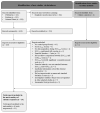Chronic Adaptations to Eccentric Cycling Training: A Systematic Review and Meta-Analysis
- PMID: 36833557
- PMCID: PMC9957439
- DOI: 10.3390/ijerph20042861
Chronic Adaptations to Eccentric Cycling Training: A Systematic Review and Meta-Analysis
Abstract
This study aimed to investigate the effects of eccentric cycling (ECCCYC) training on performance, physiological, and morphological parameters in comparison to concentric cycling (CONCYC) training. Searches were conducted using PubMed, Embase, and ScienceDirect. Studies comparing the effect of ECCCYC and CONCYC training regimens on performance, physiological, and/or morphological parameters were included. Bayesian multilevel meta-analysis models were used to estimate the population's mean difference between chronic responses from ECCCYC and CONCYC training protocols. Group levels and meta-regression were used to evaluate the specific effects of subjects and study characteristics. Fourteen studies were included in this review. The meta-analyses showed that ECCCYC training was more effective in increasing knee extensor strength, vastus lateralis fiber cross-sectional area, and six-minute walking distance compared to CONCYC. Moreover, ECCCYC was as effective as CONCYC in decreasing body fat percentage. CONCYC was more effective in increasing V˙O2max and peak power output attained during concentric incremental tests. However, group-level analyses revealed that ECCCYC was more effective than CONCYC in improving V˙O2max in patients with cardiopulmonary diseases. ECCCYC is a viable modality for exercise interventions aiming to improve parameters of muscle strength, hypertrophy, functional capacity, aerobic power, and body composition, with more advantages than CONCYC training in improving neuromuscular variables.
Keywords: COPD; aerobic capacity; eccentric exercise; strength.
Conflict of interest statement
The authors declare no conflict of interest.
Figures







References
-
- Roig M., O’brien K., Kirk G., Murray R., McKinnon P., Shadgan B., Reid W.D. The effects of eccentric versus concentric resistance training on muscle strength and mass in healthy adults: A systematic review with meta-analysis. Br. J. Sport. Med. 2019;43:556–568. doi: 10.1136/bjsm.2008.051417. - DOI - PubMed
-
- Murphy M.C., Travers M.J., Chivers P., Debenham J.R., Docking S.I., Rio E.K., Gibson W. Efficacy of heavy eccentric calf training for treating mid-portion Achilles tendinopathy: A systematic review and meta-analysis. Br. J. Sport. Med. 2019;53:1070–1077. doi: 10.1136/bjsports-2018-099934. - DOI - PubMed
Publication types
MeSH terms
LinkOut - more resources
Full Text Sources

